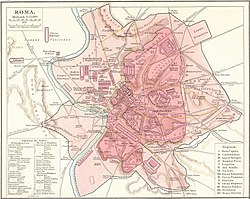Baths of Diocletian

The basilica of Santa Maria degli Angeli e dei Martiri, built in the remains of the baths.
|
|
| Location | Regione VI Alta Semita |
|---|---|
| Built in | 306 AD |
| Built by/for | Diocletian |
| Type of structure | Thermae |
The Baths of Diocletian (Thermae Diocletiani) were public baths in Rome, in what is now Italy. Named after emperor Diocletian's Baths and built from 298 to in 306, they were the largest and most impressive of the imperial baths. The project was originally commissioned by Maximian upon his return to Rome in the autumn of 298 and was continued after his and Diocletian's abdication under Constantius, father of Constantine.
The Baths occupy the high-ground on the northeast summit of the Viminal, the smallest of the Seven hills of Rome, just inside the Agger of the Servian Wall. They served as a bath for the people residing in the Viminal, Quirinal, and Esquiline quarters of the city. The Quadrigae Pisonis, a 2nd-century monument with various reliefs, some private homes, and a relief representing the temple of Quirinus once stood at the site but were demolished to build the baths. The water supply was provided by the Aqua Marcia, an aqueduct that had long served the city of Rome since the early 2nd century. To properly supply the baths, the supply of water to the city was increased under the order of Diocletian. The baths may have also been supplied by the Aqua Antoniniana, which was originally positioned to supply Caracalla's baths in the early 3rd century.
The Baths were commissioned by Maximian in honor of co-Emperor Diocletian in 298, the same year he returned from Africa. Evidence of this can be found in bricks from the main area of the baths, which distinctly show stamps of the Diocletianic period. These, according to the ancient guidebook Mirabilia Urbis Romae, were known as "Palatium Diocletiani". This evidence shows the effect of the massive project on the brick industry in that all work by them was redirected and under control of the emperor. Building took place between the year it was first commissioned and was finished sometime between the abdication of Diocletian in 305 c.e. and the death of Constantius in July 306 AD. The Baths remained in use until the siege of Rome in 537 when the Ostrogothic king Vitiges cut off the aqueducts.
...
Wikipedia

